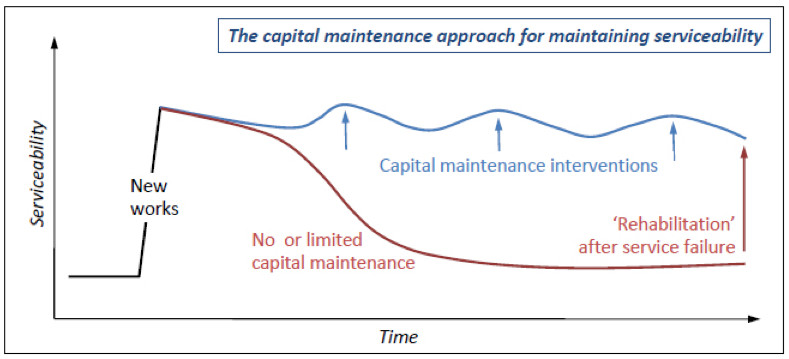Capital Maintenance Expenditure (CapManEx)
Capital maintenance expenditure is the costs of renewing, replacing, rehabilitating, refurbishing or restoring assets to ensure that services continue at the same level of performance that was first delivered. Examples include replacing a motor on a power pump or the pump rods/rising main/handle in a handpump; cleaning/re-excavating the base of a hand-dug well; relaying the drainage field for a septic tank; flushing a borehole which no longer delivers the desired flow; cleaning a water tank, etc. The renewal of these assets, often after some years of operation, ensures the same level of service that users received when the asset was first installed.
Planning for capital maintenance expenditure is crucial to the sustainability of water, sanitation and hygiene services as shown in figure 1. The red line shows a steady decline in service levels in the absence of capital maintenance as a system degrades over time. Eventually there is a need for renewed capital expenditure to replace the asset. The blue line shows service levels being maintained as the asset is maintained.
Difference between operational expenditure and capital maintenance
When an existing system undergoes minor maintenance, for example regular greasing of bearing points or tightening of pump bolts, the related cost is part of operational and minor maintenance expenditure (OpEx). The point where minor maintenance becomes capital maintenance is a matter of frequency; ‘does the cost occur more than once a year?’ and of amount; ‘Is the cost significant compared to the on-going operational expenditure?’. For example, although the cost of emptying a twin pit or shallow pit-latrine may be significant compared to the initial investment needed for construction, it occurs frequently, at least compared to the life cycle of the latrine itself, and does not constitute a physical renewal. Thus, it is considered as operational and minor maintenance expenditure (OpEx). However, the cost of emptying a single deep pit might only be needed once every five to ten years and might usefully be considered as capital maintenance expenditure. The replacement of a small valve on a piped system, or repairing a leaking pipe is operational and minor maintenance expenditure (OpEx), although its failure can significantly affect the serviceability of the system, because this is a small cost which occurs frequently compared to the life of the system. Replacing a length of pipe because there have been a number of leaks, or replacing a major valve after several years of use would be classified as capital maintenance expenditure.

